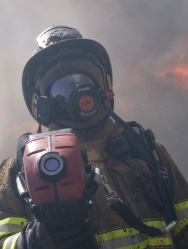 |
| Scott’s Eagle Imager 320 with Pak-Tracker locator system. |
 |
| The ISG/Infrasys Elite XR is the updated version of the popular Elite thermal imager. |
 |
| Bullard’s T4MAX and Eclipse thermal imagers. |
Thermal imaging cameras have become indispensable tools for fire departments. With their ability to “see” into smoke-filled areas, they allow firefighters to identify hot spots and to keep an eye on each other’s locations.
It is a measure of the usefulness of thermal imagers that the National Fire Protection Association (NFPA) formulated specifications for the devices in the new NFPA 1801 standard on thermal imagers, which took effect early last year. And, it is a measure of the complexity of thermal imagers that the standard is already being revised.
“Prior to 2010, there was no NFPA standard in place for thermal imagers,” said Robert Athanas, the president of Safe-IR, a company that provides thermal imager training. “As a result, the industry pretty much ruled the roost when it came to setting thermal imager specs and operating design. They have done a good job and brought good products to market. However, for the fire service to continuously get the full benefit of the technology, standardization is necessary.”
Athanas is a member of the NFPA committee that worked with industry and fire officials to write the 1801 standard, which he described as “one of the most technical standards ever developed by the association.” It is so complex that the initial version has some faults – errors so minute, yet important that only industry experts would notice them. As a result, the standard has effectively been suspended while the problems are resolved.
Specifically, Athanas said, the new thermal imager standard is going through “some editorial corrections” in a process that circumvents the normal five-year revision cycle for NFPA standards and is expected to produce tentative interim amendments (TIAs) to NFPA 1801. “It is anticipated that this process will be completed in March 2011,” he said.
The initial problems with NFPA 1801 underscore just how difficult it is to set standards for complex electronic equipment. However, NFPA officials said the effort is justified, given the widespread use of thermal imagers by firefighters.
“There are a number of reasons why we need NFPA 1801,” Athanas said. “The most pressing reason is standardization. Being able to operate a thermal imager made by company A is no guarantee that you will be able to operate one made by company B. There’s almost no common ground on resolution levels and sensitivity, or even the colors of the on and off buttons.”
Standardization has other important implications. “A fire department can spend thousands buying thermal imagers from one company with no guarantee that a compatible product will be available a few years from now,” Athanas said. “Even the batteries change from year to year. Can you imagine trying to equip a fire department with hoses and nozzles under such conditions?”
In formulating the thermal imager standard, NFPA officials invited any interested people to participate. “All of the manufacturers were given the chance to have input into the NFPA 1801 standard process,” Athanas said. “The process allows for and encourages participation from not only committee members, but the public too.”
Interviews with thermal imager manufacturers show support for the NFPA’s efforts to develop the 1801 standard and to resolve the problems that surfaced after it took effect.
“Those issues have to do with design consistencies, certain performance minimums and durability,” explained John Hays, Bullard’s product manager for thermal imaging. “We do expect those problems to be sorted out, and some form of testable standard to be in place sometime in 2011.”
David Little, a spokesman for ISG/Infrasys, said his company was a founding member in 2005 of the task group that advocated for development of a standard. “The other two founding members were Mine Safety Appliances (MSA) and Safe-IR,” he noted. “The main vision of 1801, from its very inception, was to standardize the operation of thermal imagers.”
The task group members, he said, wanted to make sure any firefighter would be able to pick up any camera and be effective with it. “Having standardized screen output, standardized button operability, and a standard temperature colorization hierarchy will be extremely useful to firefighters,” he said.
Little noted that NFPA 1801 also sets performance criteria. “For years, thermal imagers manufactured by leading reputable companies, including ISG/Infrasys, have been tough and safe to use,” he said. “What the new NFPA standard does is raise the bar such that any new entrants meet certain minimum criteria.”
MSA is represented on the NFPA 1801 committee, and Shane Bray, the company’s product manager for thermal imagers, is looking forward to resolving problems with performance criteria. “Due to the issues involved with the initial version of NFPA 1801, which came out in February 2010, manufacturers still cannot test their cameras to see if they meet the standard,” he said. “TIAs related to the standard need to be processed, and we believe the standard issues will be resolved by March 2011.”
At Scott Health & Safety, Jeff Emery, the company’s marketing manager for the fire services, said, “We strive to meet and exceed standards, as we know that NFPA standards are driven by real-life challenges facing fire departments.”
He also said Scott designs its products to safely meet real market challenges, regardless of whether a formal standard is in place.
With the new NFPA 1801 thermal imaging standard in a state of flux, should fire departments postpone purchases until all issues are resolved?
Athanas does not advocate waiting.
“If you have the funding now, get the cameras now, but do your research to ensure that this equipment has a future,” he said. “In other words, ask the manufacturers how long they intend to support the designs that you are considering. This is no guarantee that your purchases will be future-proof, but it does improve your odds.”
More Fire Apparatus Current Issue Articles
More Fire Apparatus Archives Issue Articles

